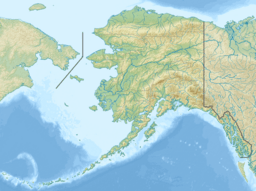Mount Abbe facts for kids
Quick facts for kids Mount Abbe |
|
|---|---|

Mount Abbe, north aspect
|
|
| Highest point | |
| Elevation | 8,200 ft (2,500 m) |
| Prominence | 938 ft (286 m) |
| Geography | |
| Location | Glacier Bay National Park and Preserve Hoonah-Angoon Alaska, United States |
| Parent range | Fairweather Range Saint Elias Mountains |
| Topo map | USGS Mount Fairweather D-4 |
| Type of rock | Granite |
| Climbing | |
| First ascent | June 11, 1977 |
| Easiest route | Mountaineering |
Mount Abbe is a tall mountain with two peaks, located in a beautiful part of southeast Alaska. It's part of the Fairweather Range within the Saint Elias Mountains. This mountain stands proudly near the end of the Johns Hopkins Glacier, inside Glacier Bay National Park and Preserve. It's about 100 kilometers (62 miles) northwest of Juneau. Even though it's not the tallest mountain around, it looks very impressive because it rises sharply from the ocean in just a short distance. Many people on cruise ships enjoy seeing and photographing Mount Abbe with the Johns Hopkins Glacier.
Contents
About Mount Abbe
Mount Abbe is an impressive mountain in southeast Alaska, standing over 8,200 feet (2,499 meters) tall. It has two main peaks, which is why it's sometimes called a "double summit." This mountain is part of the Fairweather Range, which is a section of the larger Saint Elias Mountains. It's found within the stunning Glacier Bay National Park and Preserve.
The mountain is very close to the Johns Hopkins Glacier, a popular spot for visitors on cruise ships. Because it rises so steeply from the water, it offers amazing views, even though its height isn't as extreme as some other mountains.
Naming the Mountain
Mount Abbe was named in 1936 by two explorers, William Osgood Field and William Skinner Cooper. They were part of the American Geographical Society. They named the mountain after Cleveland Abbe Jr. (1872-1934), who was an American geographer.
Cleveland Abbe Jr. earned his Ph.D. from Johns Hopkins University in 1898. Two glaciers on Mount Abbe's slopes were also named to honor people connected to the university. The Gilman Glacier was named for Daniel Coit Gilman, the university's first president. The Clark Glacier was named for William Bullock Clark, a geology professor there. The name "Mount Abbe" was officially accepted in 1937 by the United States Geological Survey.
Climbing Mount Abbe
The first time someone successfully climbed the south peak of Mount Abbe was on June 11, 1977. This challenging climb was completed by Jim Wickwire and Dusan Jagersky. They took a route up the Southeast Face of the mountain.
Later, on July 14, 1991, the north peak was successfully climbed for the first time by Walter Gove and William Pilling. The best time to try climbing Mount Abbe is usually from May through June, when the weather is most favorable. However, it's known to be a very difficult climb, and not many people attempt it.
Weather and Glaciers
Mount Abbe has a subarctic climate. This means it experiences very cold, snowy winters and mild summers. Temperatures can drop extremely low, sometimes feeling colder than −30 °C (which is −22 °F) when you include the wind chill.
This cold climate helps support the large glaciers on the mountain's slopes. These include the Clark Glacier, Johns Hopkins Glacier, and Gilman Glacier. Water from melting ice on these glaciers flows into the Johns Hopkins Inlet, which is part of Glacier Bay Basin.
Images for kids
See also
 In Spanish: Monte Abbe para niños
In Spanish: Monte Abbe para niños




